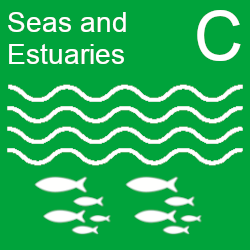Short Description
This indicator will track the health of our seas using metrics based on the size, structure and function of different feeding (trophic) levels in marine food webs. The indicator will focus on pelagic (water column) habitats and populations of key species groups within the food web. The indicator will also link to and complement C9 Healthy seas: Seafloor habitats functioning. These show whether ecosystems are healthy and are being used sustainably. Currently, the metrics within this indicator are being developed for the UK Marine Strategy Descriptors 1 (biodiversity), 4 (food webs) and 6 (seafloor integrity) and the Convention for the Protection of the Marine Environment of the North-East Atlantic (OSPAR).
Readiness and links to data
An interim indicator is presented here based upon the pilot assessment of feeding guilds, published as part of the OSPAR Quality Status Report (QSR) 2023. Additional data on modelled and observed fish feeding traits for the North Atlantic and Arctic Oceans has been published on Cefas Data Hub, and will be incorporated here in a future update to the Outcome Indicator Framework. A Food Webs Thematic Assessment, conducted via the OSPAR QSR (2023) is also available, which summarises the overall status of marine food webs in the OSPAR region.
Ongoing developments include the collation of more stomach content data to further resolve predator diets and to identify the drivers behind changes in feeding guild biomass. Stomach content data are publicly available from International Council for the Exploration of the Seas (ICES) stomach content data portal and the Cefas Integrated Database and Portal for Fish Stomach Records. Fisheries-independent survey data are also available from the ICES Database of Trawl Surveys (DATRAS).
Notes on indicator
A chart is not currently presented in the Outcome Indicator Framework, but spatial representations and figures supporting this interim indicator can be accessed via the OSPAR QSR (2023) pilot assessment of feeding guilds.
There is currently no desired direction of change for this indicator, further work is planned to identify a baseline and drivers behind changes to determine whether food webs are improving or deteriorating. An increase or decrease in biomass in any of the feeding guilds may reflect an improvement or deterioration, depending on the cause of change. Anthropogenic pressures such as fishing activity, climate change and nutrient pollution can directly drive increases or decreases in the biomass of a feeding guild, depending on how the specific pressure affects habitat conditions, the fish assemblage, and their various prey. Such pressures can also have indirect effects across the food web, by reducing predator pressure from one feeding guild and causing increases in the biomass of fish prey in another feeding guild, for example. Conversely, a reduction in the biomass of one feeding guild that are prey for another could reflect recovery of the food web, as larger piscivorous fish biomass is restored via effective fisheries management. Whilst it is not possible to identify a driver for the changes presented here, change in the composition and biomass of feeding guilds could cascade through the food web, affecting fish prey (for example, zooplankton) and predator assemblages (for example, marine mammals and birds), and could impact the human food chain via disruption of edible components.
Indicator components
Trend description for C8
Whilst further improvements to this indicator are planned to identify drivers behind the change and a desired direction of change, it shows that fish feeding guilds are changing and therefore are not stable which may be a cause for concern.
The biomass of planktivores (fish lower in the food web that feed on plankton) declined in the Celtic Sea and north-western North Sea but increased in the English Channel, Bristol Channel and west of Scotland.
The biomass of benthivores (fish lower in the food web that feed upon organisms on the sea floor) increased across the Irish Sea, to the north and west coast of Scotland, in the southern North Sea and eastern English Channel. There were spatially small-scale decreases in benthivore biomass south of Ireland in the Celtic Sea.
The biomass of pisco-crustivores (fish higher in the food web which feed upon small fish and crustaceans at the sea floor) was decreasing in some areas of the northern North Sea and between Scotland and Northern Ireland but increasing over much of the rest of the study area.
The biomass of piscivores (fish high in the food web which feed upon other fish) was increasing north and west of Scotland, in the Celtic Sea, northern Irish Sea, southwestern North Sea but decreasing in the west of the North Sea.
The latest OSPAR Thematic Assessment (2023) for food webs which covers all OSPAR Regions and indicators concludes that food webs are not in good environmental status.
Assessment of change
No assessment was undertaken for this indicator as a suitable time series is not yet available in the Outcome Indicator Framework.

